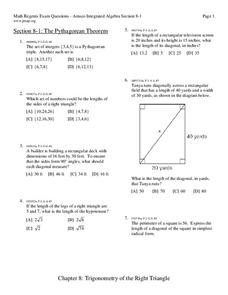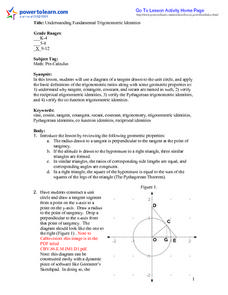Curated OER
Let the Sun Shine In: Energy Conservation
Students create a project applying their math skills as they discuss energy conservation. In this geometry lesson, students define vocabulary relating to the environment and energy conservation. They construct a building that allow lots...
Curated OER
Applications of Triangles
Students apply the properties of a right triangle. In this triangle lesson, students describe and compare radians to degrees. They solve problems using the properties and ratios of a right triangle.
Curated OER
Triangle Inequality Theorem
Learners use the inequality theorem to solve triangles and their properties. In this geometry lesson, students are given spaghetti of different lengths and asked to create triangles. They conclude the necessary length needed to make a...
Curated OER
How Tall is that Tree?
Students apply their math skills to develop an accurate estimate of the height of a tall tree. Three different methods are outlined. All grade levels should be able to perform the shadow method and the proportional method.
Curated OER
Can You Make a Hole in One?
Young scholars relate miniature golf to reflection of an image. In this algebra lesson, students collect and graph data as they study linear equations. They apply properties of graphing to solve real life scenarios.
Curated OER
The Pythagorean Theorem
In this geometry instructional activity, students solve missing parts of a triangle using the Pythagorean Theorem. There are 19 questions with an answer key.
Curated OER
This Building is Tall
Learners calculate the perimeter of shapes. In this geometry lesson, students relate properties of polygons to the real world. They find length, midpoint and slope.
Curated OER
Hot Wheels
Young scholars observe the action produced by toy cars. In this geometry lesson, students discuss motion and distance as they relate to the movement of a spherical object.They collect data and make conjectures based on their data.
Curated OER
Understanding Fundamental Trigonometric Identities
Young scholars are introduced to the basic trigonometric identities. Using a diagram, they discover why the parts of the unit circle as named as they are and use equations to finalize the Pythagorean trigonometric identities. They also...
Curated OER
Quadratics: Polynomial Form
Students determine how changes in the coefficients in a quadratic function affect its graph. They Solve a quadratic equations. Students Determine how to use the equation to determine the intercepts of a quadratic function. They...
Curated OER
Quadratics: Polynomial Form
Students determine how changes in the coefficients in a quadratic function affect its graph. They determine how to use the equation to determine the intercepts of a quadratic function. Students identify the location of the intercepts...
Curated OER
The Corner Problem
Students explore the concept of the corner problem. In this corner problem lesson, students use the TI-NSpire to determine the maximum length a rod can be and still pass horizontally around a corner. Students use similar triangles to...
Curated OER
Parallax
Students discover how astronomers used the diameter of the Earth's orbit around the Sun as a baseline for estimating the distance of some stars, and the meaning of "Parsec" and "light year."
Curated OER
How Distant is the Moon?--2
Students examine total eclipses of the Sun and their limited regions of totality. They explain that this limited view occurs because the Moon is close enough to us for different points on Earth to view it differently.
















